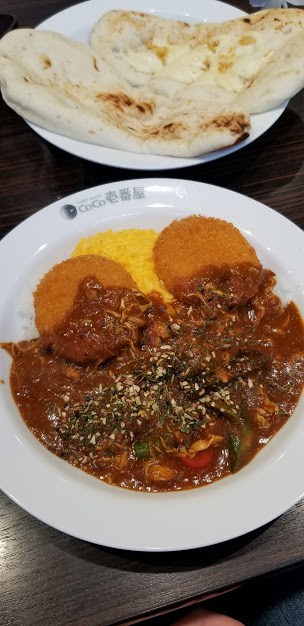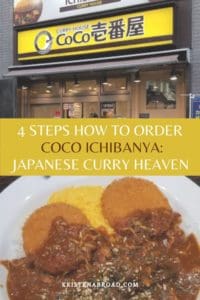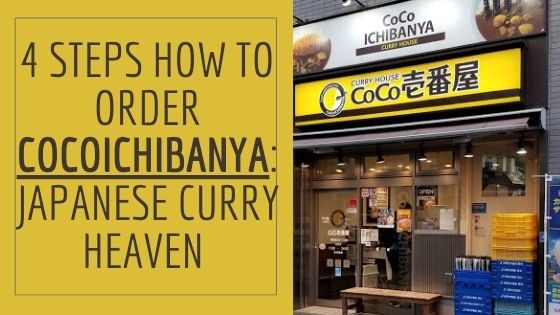You might be surprised to learn that Japanese curry is one of the most popular dishes in Japan, on par with considering it a “national dish”. Originally introduced by the British during the Meiji period, it is still considered to be 洋食 (yoshoku, western food) but definitely it’s own creation now. Thicker than Indian or Thai curry, it is made with a roux and often seen as a beef stew. There are so many different variations though. Regional local specialties at mom and pop shops. “House” curry you’ll find in retort packets at the grocery stores. Navy curry on the JMSDF ships and then there is CoCoICHIBANYA. A quick and delicious chain restaurant.
- Curry House CoCoICHIBANYAor “CoCoICHI” History
- What makes Japanese Curry, Japanese?
- How to order at CoCo Ichibanya
- First, select your curry sauce
- Second, Choose how much rice you want
- Third, Choose your spice level
- Fourth: Toppings!
- Watching Calories or Special Dietary Restrictions with CoCoICHIBANYA
- Limited Edition Menus
- Making CoCo Ichibanya at home
- Masked CoCoICHI (マスクドCOCO壱)
[Editor’s Note: This post was originally published in August of 2018 and has been updated for freshness, accuracy, and comprehensiveness.]
Curry House CoCoICHIBANYAor “CoCoICHI” History
The Curry House at the beginning of the name is normally dropped off in conversation to leave you CoCo壱番屋 (CoCo ICHIBANYA, romanized with all capitalized letters at the end) or mostly abbreviated as CoCo壱 (CoCoICHI) was first established in 1978 in Nagoya. Specializing in Japanese-style curry, it is now a chain restaurant that has expanded greatly over the years.
First went overseas to Hawaii in 1994 and now it can also be found in 12 overseas countries. 185 of 1482 (as of April 2020) CoCoICHIBANYA locations are overseas!
Sadly, the ones in my home country of America are all in California and Hawaii but I’m still holding out that the east coast will eventually get one!
If that seems like a lot of stores, it is! In January of 2013, CoCoICHIBANYA received the title of “the largest chain of curry restaurants in the world”.
What makes Japanese Curry, Japanese?
It’s actually very hard to peg down as it has so many different variations. And it’s quite common for families to have their own curry recipe. You’ll also see some hotel restaurants with “hotel” curry. It just means it’s their recipe.
Roux is definitely the binding factor (see what I did there?). As such, Japanese curry is thicker than most other Asian curry varieties.
I liken it to a savory gravy served over rice, in the case of curry rice (カレーライス, that’s a “rey” sound, not a “ri” in ka-rey rai-su, katakana can be strange). But you will also see it over noodles, like with curry udon, and in bread (Japanese bakeries have the craziest, delicious varieties of bread products!) as well.
In general, it’s much sweeter and less spicy than other curries you may be familiar with. While most mom-and-pop curry restaurants might have a “normal” and one or two levels of “spicy” curry, CoCo Ichibanya takes the spice game to a whole other level.
How to order at CoCo Ichibanya
The best part about CoCoICHIBANYA (or CoCo’s as most American’s call it), is how customizable it is. Sure, they have a massive menu full of all different combinations already laid out for you, it’s just as easy to order it specifically. There’s usually an English menu to help out. If not, the pictures are always a good backup.
First, select your curry sauce
The important thing that makes it curry is the curry sauce, so you pick that first! The meat options have small chunks of the meat in them but really it is to inundate the flavors.
If you don’t make a different specification, the pork curry sauce is the 普通 (futsuu, normal – not to be confused with the same word being used for local trains) and what will be served.
- Pork Curry
- Sweet Pork Curry (this is also used in the Children’s option)
- Beef Curry
- Vegetarian Curry
- Hashed Beef
Second, Choose how much rice you want
The “base” option will give you 300 grams of rice, that’s a lot for me personally. You can dip down to 200 grams which will also give you a small cost savings (and there is an option for a bit smaller we’ll get to in a minute). But you can also get massive portions of rice. Just go in 100-gram increments, and while the menu shows something like 900 grams (yikes) as maxing out, you could get more if you wanted.
Third, Choose your spice level
Whereas most food in Japan is relatively mild, CoCo Ichibanya definitely knows how to kick it up a notch. Above “normal” which CoCo Ichibanya considers “medium” spice level, there are ten levels of spice you can go through.
Don’t think for a second that is a linear scale though!
- Level 1 Spicy = Baseline that the following levels are based off.
- Level 2 Spicy = Twice as spicy as level 1
- Level 3 Spicy = Four times as spicy as level 1
- Level 4 Spicy = Six times as spicy as level 1
- Level 5 Spicy = 12 times as spicy as level 1
- Level 6 Spicy = 13 times as spicy as level 1
- Level 7 Spicy = 14 times as spicy as level 1
- Level 8 Spicy = 16 times as spicy as level 1
- Level 9 Spicy = 18 times as spicy as level 1
- Level 10 Spicy = 24 times as spicy as level 1
And per their menu, they won’t let you go above 5 without proving you don’t die with level 5 first! I have seen a few exceptions to that rule but they do actually get spicy fast.
While I now default to a level 6 or 7, it took me many meals to rise to that level. So if you like spicy food as I do, this is definitely a place for you.
However, if spice is NOT your thing, you can also add sweetness levels to your curry, from 1 to 5. The sweet sauce has honey in it though, so they warn against giving it to babies under 1. You can thank them for adding the sweetness levels in 2015.
Fourth: Toppings!
There are plenty of combinations in the menu already picked out for you, and you can choose one of those and go for it. Or you can create your own from the 40 or so toppings. OR you can use something on the menu and still add something else to it. Skies the limit on options here at CoCoICHIBANYA. While not all-inclusive, here’s some of the toppings that I pulled from the menu:
- Eggplant
- Spinach
- Cheese
- Scrambled Eggs
- Cream Croquette with Crab
- Natto
- Mushrooms
- Garlic
- Pork Cutlet
- Sausage
- Lightly Crisped Chicken
- Stewed Chicken
- Thinly Slicked Pork
- Hamburger
- Chicken Cutlet
- Fried Fish
- Squid
- Shrimp Cutlet
- Mixed Seafood
- Mixed Vegetable
Watching Calories or Special Dietary Restrictions with CoCoICHIBANYA
For calorie watching, you can go with the “スモールサイズカレー” (Small size curry) or “Mini Curry” as it’s translated into English. Instead of the normal 300 g of rice, it comes with 150 grams of rice and the portions of the other ingredients are also smaller. For instance, I love getting the croquette added to my curry. They normally would be to give you TWO. That’s a lot. With the mini option, you get one! And if you want to add extra toppings, you can still do that.
If you just want slightly less rice, but still the same size toppings, go with the 200 grams I mentioned before.
There is also a low carb version which uses 180 grams of cauliflower (カリフラワー) instead of rice! Before you ask, yes, when they give the grams, they mean it! They’ve got weighing machines in the kitchen.
For vegetarians, there is the vegetarian curry option and there is usually a menu just for vegetarians. Still craving a cutlet? They have a soy meat version, look for “大豆ミート”.
If you have allergies to certain food items, CoCoICHIBANYA has a convenient allergy information sheet in English and Japanese to help.
Limited Edition Menus
My suggestion? Go with the seasonal, regional or store specific menus for a real treat. Some examples of the seasonal menu are vegetable or chicken soup curry or Pumpkin and winter vegetable curry. The summer “spicy” (as in spice flavor, not spice hot) chicken and vegetable is AMAZING.
And if you go with a regional/store, you’ll always have something new if you need a quick bite. Like in Kansai where they had a special 牛すじ煮込みカレー (Gyu-suji nikomi, stewed beef tendon curry).
For local options, in my area, we have よこすか海軍カレー (Yokosuka Kaigun or Navy Curry). The two “downtown” Yokosuka stores, plus the Oppama store and a little farther away to Kanazawa Hakkei (easily accessible on the Keikyu Line), have something called マスクドCOCO壱監修ホットエナジーカレー, which translates roughly to “the masked CoCoICHI supervised this hot energy curry”. More on the masked guy in a bit.
If I have my story straight, it was part in thanks to the Yokosuka stores (the two downtown and one in Oppama are owned by the same person) pressing for some “local specialties” as to why these became a thing. More on how Yokosuka and Curry go together another time.

Disclosure: Kristenabroad.com is a participant in the Amazon Services LLC Associates Program and other affiliate programs. For some links to products or services in this article, I may earn a small commission by you using my link. The price for you is not affected.
Making CoCo Ichibanya at home
If you are in Japan, you can find CoCo Ichibanya retort packets online which make for great snacks when you just need a quick meal. Especially when you can get pre-made rice at the convenience store. I know, I know, the sacrilege. I do have a super awesome rice cooker too.
If you want some of the local flavor options, you can order the Yokosuka CoCo Ichibanya retort packets online, or at the shops themselves.
Masked CoCoICHI (マスクドCOCO壱)
I’ve been lucky to see the masked CoCoICHI several times. He’s the official mascot of CoCoICHI and wears a Mexican wrestling mask. Similar to the luchador masks defining a wrestler’s identity and keeping a persona, this works the same for the masked CoCo ICHI.
And persona does he have. The mask is bright gold with “CoCo Ichibanya” all over it, so he’s hard to miss if you happen to run into him. He’s got a great social media account with all his silly antics, and he’s also been blogging about Masked CoCo Ichi since August of 2011 (!!).
Pin this for later

